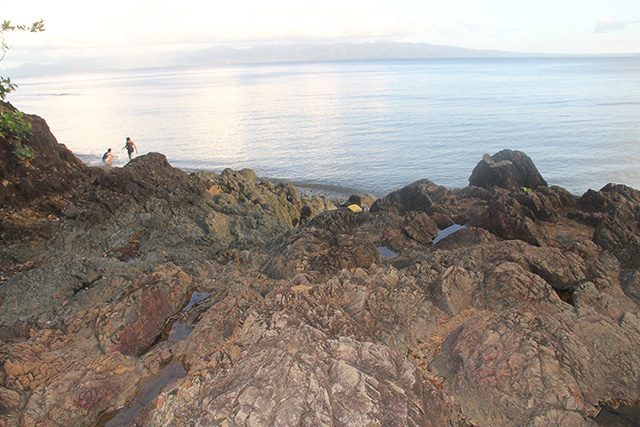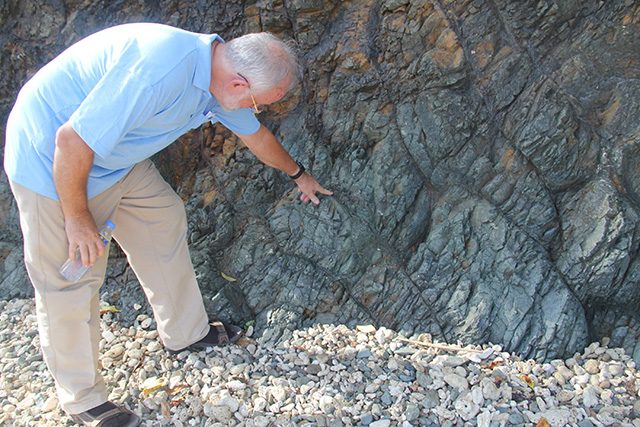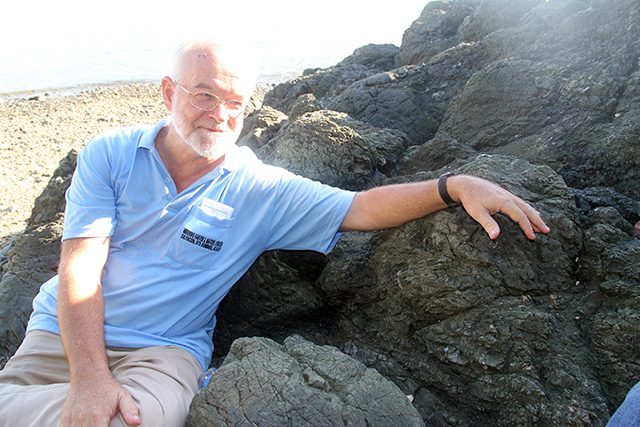SUMMARY
This is AI generated summarization, which may have errors. For context, always refer to the full article.

ALBAY, Philippines – The seashore of Mirisbiris beach in Salvacion, Santo Domingo town, holds an ancient geologic formation: the beach is home to ancient pillow lavas, formed millions of years ago.
The formation was discovered by world-renowned geologist Christopher Newhall, after he and his Filipina wife Glenda acquired land in the village.
Newhall said that the pillow lavas were most probably generated through submarine volcano eruption or plate tectonic movement, most probably during the Cretaceous period – some 65 to 100 million years ago, when dinosaurs were still ruling the planet.
“We really don’t know the source of these pillow lavas, if this is [from] beneath the sea, but one thing is for sure: this was shaped during the Cretaceous period or during the Jurassic age,” he said.
Pillow lavas are rock formations of volcanic origin, called such due to its similarity to piles of pillows. The volcanic action takes place under the sea: when a submarine volcano erupts, molten lava is ejected, and the lava rapidly solidifies on the outside due to contact with cold water.
The still-molten lava underneath then ruptures the surface, forming another layer of solidified lava. This process takes place numerous times, and the result looks like a mass of pillows on top of each other.

The pillow lava in Barangay Salvacion probably came from the uplifting of the sea floor due to collision of undersea plates, or from a possible ancient submarine volcano within the Albay Gulf area, Newhall explained.
“The people of this town are unaware of the existence of ancient history that shaped this town,” he said.
From the USGS to Albay
The discovery of the pillow lavas is just a continuation of Newhall’s decades-long work as a geologist, who moved to the Philippines permanently after decades of working with the US Geological Survey and then at the Earth Observatory of Singapore.
Newhall first set foot in the country as a Peace Corps volunteer in 1970, teaching geology at Aquinas University in Legazpi City, before working on the USGS’s Volcano Hazards Team in Seattle as volcanologist in 1980.
He has undergraduate and graduate geology degrees from the University of California, and completed his doctorate at Dartmouth College in 1980. He was also an affiliate professor of earth science at the University of Washington for 17 years.
He has also been helping Philippine government scientists, working with the Philippine Institute of Volcanology and Seismology (Phivolcs) for years, and helping local experts study abroad to specialize on volcanology.

He has also worked closely with legendary Filipino geologist Raymundo Punongbayan. He is also credited for devising the volcanic explosivity index (VEI) – the measure by which eruptions are compared.
After years of working with the world’s top geologists, Newhall then opted to retire in Sto Domingo town to work with Albayanos. Now, he is developing a Web-linked worldwide network of volcano observatories which he believes is greatly needed to improve the ability to predict the behavior of these ticking tectonic time bombs.
Now, he and his wife Glenda are dedicated their lives to promote and preserve the value of nature, through the Mirisbiris Garden and Nature Center.
They built the center 3 years ago primarily as a private sanctuary, but they opened it to the public to to promote ecotourism and agritourism. It has a mini farm, where they have medicinal kitchen herbs, organic vegetables, and fruits. The place also serves as a venue for special events.
The center also has a mini-forest, with native species of trees such as yakal, sambulawan, katmon, mapilig, and hamurawon (molave). It also has a pebbly beach with a coral reef offshore. The reef, while partly damaged by silt, is still in reasonably good health.
“Glen and I were volunteers together for 40 years, and we decided to open Mirisbiris to the public to support scholarships for students from Salvacion and elsewhere. We’re been doing this already and are proud to have helped the students. But we can’t afford to do this alone. Former scholars are already helping new scholars and income from tourists will help greatly,” the world-renowned US geologist said. – Rappler.com
Add a comment
How does this make you feel?
There are no comments yet. Add your comment to start the conversation.